You need to work the whole water column if you’re going to successfully target most popular species, as JAMIE ROBLEY explains.
SECTION: features
MAPS:
Facts
ILLUSTRATIONS: 0
In recent years we’ve seen a variety of lure fishing trends emerge, some of which are just rehashed methods from the past with a modern flavour to them, while others are completely fresh.
Deep-water jigging for kings, soft plastics for bream and casting poppers for whiting are some that have really taken off in NSW. To make the most of any type of lure fishing, old or new, it’s important to understand why, how and when a lure should work.
Successful lure fishing is a result of some basic factors and one of the most important aspects of the game is actually getting a lure in front of a fish’s nose. If a lure isn’t near the fish, then things just aren’t going to happen.
Of course, lure fishing can be a complex game, with so many different lures on the market and new ideas constantly thrown around. That’s not to mention all the high-quality tackle now available and then there are the seasons, tides, weather and all the other pieces of the puzzle to try to put together.
For a moment, though, let’s put all the complexity aside and focus on placing the right type of lure in front of a fish to entice a strike. The following is a selection of some of our popular species that can be caught on lures, from the surface right down to the bottom.
When lure casting for bream started to evolve through the 1970s and 1980s, we just the smaller versions of our already established bass lures, predominantly floating hardbody lures that dived a metre or so under the surface. Some early favourites were the Flopy, Shakespeare Little S and Heddon Mini Tad and Tiny Tad.
Like their modern-day counterparts, these small hardbodies were fine if the fish were within a few metres of the surface or the area fished was quite shallow.
When it comes to deep-water situations, though, the most logical choice is a soft plastic mated to a jig head with enough weight to get down there before the current simply sweeps it away.
In some parts of Lake Macquarie, for example, bream may be found down at 7m or 8m but because of a lack of strong current a jig head of 1/8oz may be right on the money. Fish the same depth in the Hawkesbury River or at The Rip bridge in Brisbane Water and chances are a heavier jig head will be required to deal with strong current.
Along the extensive rock walls of rivers like the Clarence or Macleay, quite a lot of bream will be found right up against the rocks, just under the surface. But just as many bream or more may be lurking deeper down. A small hardbody cast up against the rocks will catch quite a few bream but will miss any deeper fish.
By casting a jig-rigged plastic towards the rocks from a drifting boat you may get hit at any time from splashdown to when the plastic makes it down to the bottom. This is covering a lot more of the water column than a floating hard lure could do.
So overall, hardbodies may work wonders in some places but not so much in the deeper water unless you’re using a sinking model, commonly typified by the rattling lipless models.
On the other hand, lures that float up on top are a practical choice when it comes to casting over shallow weed beds or areas that are riddled with snags, rocks or fallen timber down below.
Tailor are often thought of as a surface fish. They certainly are on the surface when you can see them slashing into baitfish but, for the majority of the time, tailor will be deeper down. Sometimes they’ll even be rounding up those baitfish down deep and getting stuck right into them but you would never know unless you happened to spot this on your sounder.
A variety of lure types will catch tailor but there’s no doubting that metal lures are the most practical if you simply want to catch fish. Metals can be cast and allowed to sink to the bottom to interest the deeper tailor but they can also be skimmed across the top, almost like a popper, if that’s what it takes to turn the fish on.
Tailor also love eating surface poppers and fizzers – but not when they are down towards the bottom. As a rough guideline, tailor are more active in the surface layers around dawn or dusk and deeper down through the middle of the day, so a reasonable strategy would be to let your metals sink to the depths in the day and bring out your surface lures early in the morning or late in the afternoon.
If ever there was a bottom dweller, it’s the flathead. They probably spend more time lying on sand, mud or rock than any other fish yet they, too, will rise up to the surface looking for a meal at times. If there is a large pack of baitfish well above the bottom, it’s not too much trouble for a flattie to quickly zoom up, grab a bite to eat and then go back to rest again.
At night I’ve seen some very big flathead cruising around, almost doing laps, under spots illuminated by overhead lighting. These fish are right up on top and at first I thought I was seeing jewfish or even cobia.
Because mullet were congregating on the surface, the big lizards would casually swim directly below a few mullet and then snap like a big rat trap to get their mullet meal. In such situations a minnow-shaped hardbody like a Rapala or Viking Lancaster worked very slowly, just under the surface, is a practical choice.
Most of the time, however, a weighted soft plastic, jigged across the bottom is about the most effective flathead-catcher you could hope to use.
Like most species, jewfish may swim anywhere from the top to bottom. They do, however, have quite set times to be down deep, in mid water or up near the surface layer. Through the middle of the day, they tend to hang in the deeper, darker sections of the bottom or tucked up against reef, wreck or in a cave. This is when large, heavily-weighted soft plastics work well.
As night falls, jewies move around a lot more and will rise towards the surface, especially if large numbers of mullet, herring, pike or tailor are also up near the top.
As in the case of those big flathead, this occurs a lot where there is strong overhead lighting. Road or rail bridges are often good jewie spots at night. Larger, minnow lures like Predatek Vipers, the big Bomber Long As or 15 cm Nilsmaster Invincibles are good choices around bridges or other structure where jewies may lurk at night.
Jewfish also are often looking for a meal in the surface layers at the mouth of a river during a flood. One of the most successful lures for flood jew is the big Killalure Jewie, which dives to a maximum of only a metre – in other words, it’s pretty much a surface lure.
Many people think of snapper as bottom dwellers but they spend a good deal of time in mid-water and around dawn or dusk they’ll rise up towards the surface. Over the past 18 months my mates and I have hooked up to good snapper on soft plastics within a second or two of the lure splashing down. There’s no doubt the fish would be within 2m of the surface to grab a plastic so quickly.
The fact that snapper will eagerly tuck into a feed of dead floating cuttlefish on the surface is another good indicator of these being an ‘anywhere’ species, rather than simply bottom fish.
Deep jigging for kingfish may be the in thing at the moment but closer inshore kings often feed right up on top, or not far below the surface.
Something that really gets kings feeding on the surface is the presence of large numbers of sauries, garfish or long toms. This is when a robust surface lure like the Halco Roosta popper can be irresistible for kings and a whole lot of fun for the angler.
Soft plastics also work extremely well on kingfish in depths to 25m or more. A decent-sized plastic like a 6” Atomic Jerk Minnow matched to a sturdy 1oz jig head will really get the kings fired up when you let it sink right down and then frantically rip it back with a lot of jerky, erratic rod movement. This is certainly as effective as any new-wave metal jig on the market.
While most hardbody lures are designed to swim on top or run at a certain depth, some other lure types work quite well at all depths.
Spinnerbaits and Chatterbaits are good examples. Although they won’t float on top, they can be cast and immediately retrieved so that they are working just under the surface – a great strategy over weed beds. They can also be allowed to sink to the bottom and slowly jigged in a series of hops, much like working a soft plastic for flathead.
Lipless crankbaits can be used much in the same way and I suppose that’s one of their major appeals when it comes to bass, which tend to hang deeper through the middle of the day and start looking for food closer to the surface as the sun sinks.
However, bass, like many other fish, don’t read the rule books and it’s nothing out of the ordinary to have them hit a surface lure at any time of the day.
Overall, it pays to keep a range of different lure types in the tackle box. So many times I’ve missed out on some action because I’ve carried only a selection of soft plastics for estuary fishing. If you have similar habits, it can be a good idea to remember one or two metal lures and some poppers in case of a patch of tailor showing up or when fish like bream or whiting are smashing into prawns on the surface.

Metal lures, spinnerbaits and soft plastics can be worked at any depth to entice a strike. It pays to bring along one or two of these lures regardless of what type of fishing you do.

Trolling or casting lures that can work at 3m or more are great for flathead in the estuary or bass, cod or yellowbelly in the dams.
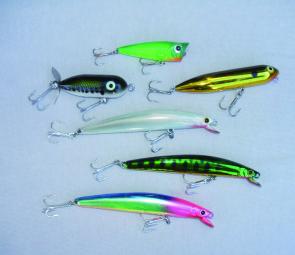
Lures that work right on or near the surface tend to be quite effective in shallow water or when fish have forced baitfish or prawns up to the surface. These Heddon, Surecatch and Viking lures are some of the author’s favourites for the top.
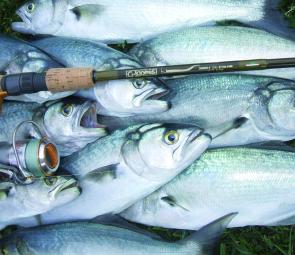
Tailor are often thought of as surface but they often hug the bottom and you won’t catch them unless your lure sinks down to them.
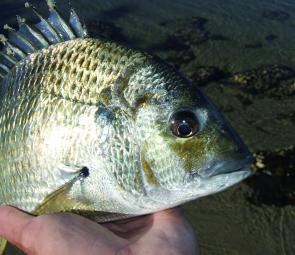
Bream can be found anywhere from top to bottom, depending on factors such as water temperature, time of day and what type of food they’re eating. The author generally favours soft plastics for bream because plastics can be effectively fished at any depth.
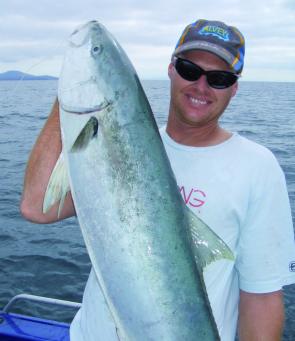
Although deepwater jigging for kingfish has become quite popular in recent years, kings often look for food towards the surface and don’t mind getting into very shallow water if food is there for them.
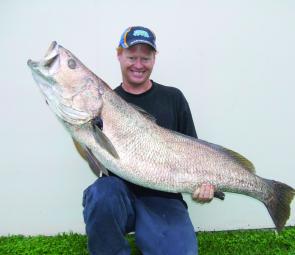
Through daylight hours jewfish tend to be found down towards the bottom. As light levels fade they often rise up to feed near the surface, especially around bridge lights.




